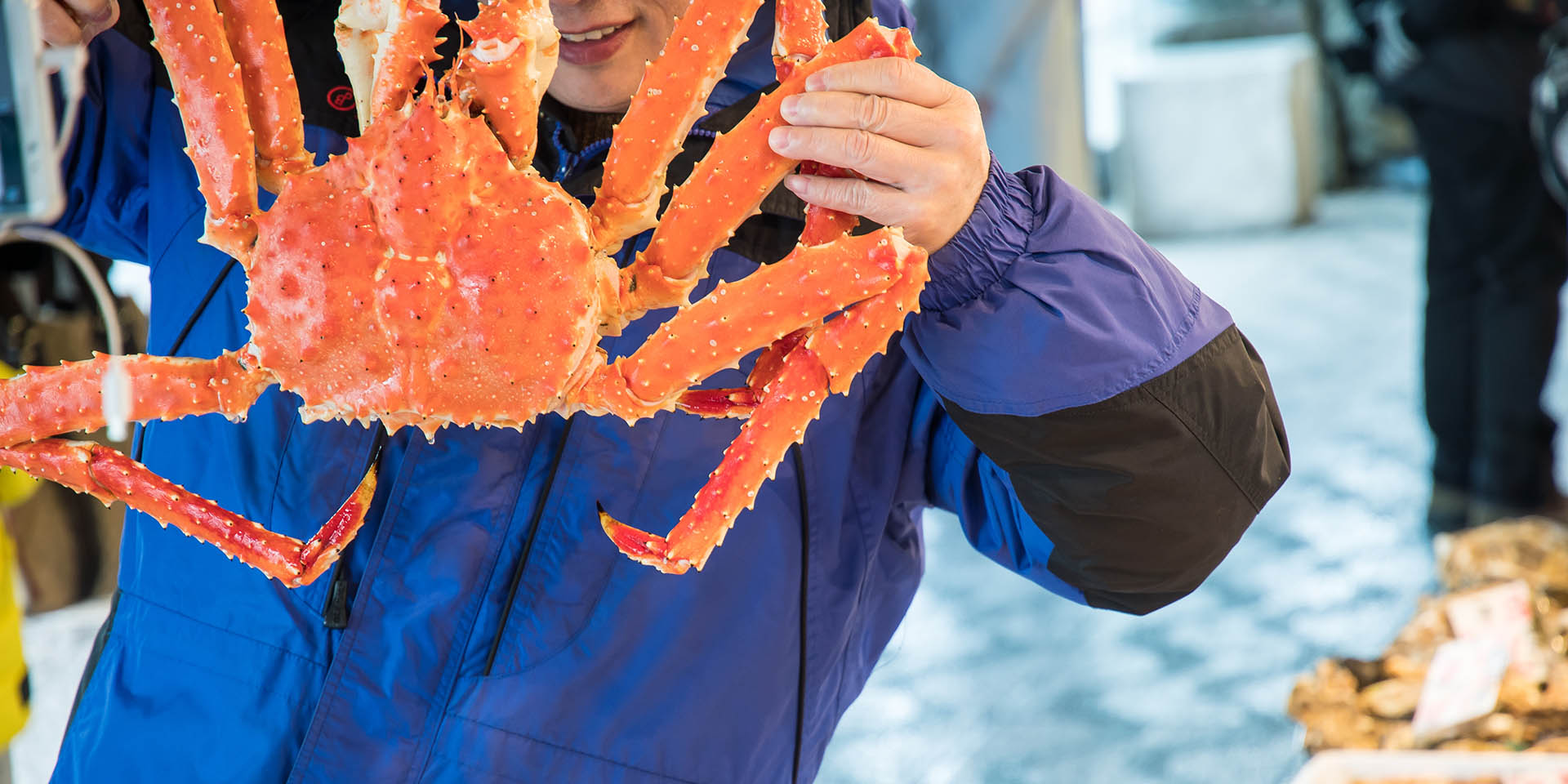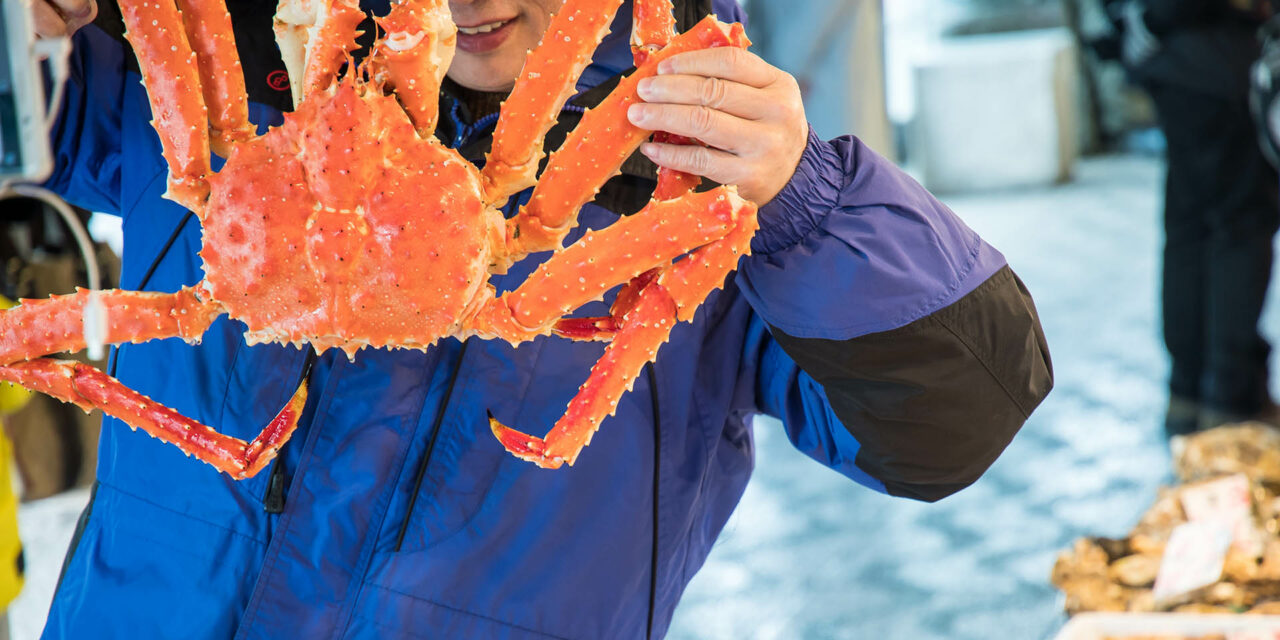WRITTEN BY
Editor, Travelogues
PUBLISHED
September 22, 2017
LOCATION
Japan
Tsukiji in Japan faces an uncertain future and, well, it also caught fire recently. Luckily the picky pescetarian can find all manner of seafood fare in open-air markets all over the country.
Now, nothing can quite replace that long Tokyo layover visit to Tsukiji for the morning tuna haul, but other cities have their own, humbler fish market offerings. From the cool, plankton-rich waters of Hokkaido to the coastal and river cities of Kyoto, Kanazawa, and Osaka, fresh fish markets abound.
Omicho Market, Kanazawa

ABOVE: The Omicho Market has been around in one form or another since the Edo Period.
Kanazawa, just a few miles from the coast, plays host to the Omicho Market. In a maze of covered side streets, Japan’s second largest fish market, Omicho – or “Kanazawa’s Kitchen” – has been around since the mid-18th century. The roughly 200 stalls and eateries include both seafood galore and other fresh produce, including flowers. Outside of the market are dozens of restaurants serving up the freshest catches from the area. Art and history lovers will also find a great deal to enjoy in the surrounding area; the Ozaki Shrine, Contemporary Art Museum, Uhoin Temple, and Hiyoshi Shrine are all found fairly nearby.
Nishiki Market, Kyoto

ABOVE: Boiled octopus at the Nishiki Market in Kyoto.
At five blocks long, it’s not the biggest fish market in Japan, but it may be one of the oldest. Kyoto’s famous Nishiki dates back to the 14th-century and retains the lively shotengai (shopping-street) atmosphere. This market is all about food – and not just the fish – offering local fresh produce, confectionery, and Kyoto culinary specialties. The best part about this market, however, comes in the form of samples – endless samples from just about every stall. There are also a few ryokans to keep in mind in the general vicinity.
Nijo Market, Sapporo

ABOVE: The cold, plankton-rich waters of Hokkaido give the fish in Sapporo special qualities.
Get to the market at seven, sit at one of the many restaurants, and dig into that Hokkaido seafood sensation; nowhere quite does seafood breakfast like Nijo Market in Sapporo. Japan’s northernmost island prefecture Hokkaido is famed around the globe for its crab and shellfish. The cool waters and thriving plankton give Sapporo’s markets some very unique seafood, including fish that grow larger and fatter than anywhere else. The best time to go will be in a few months for the February Sapporo Snow Festival, which combines that natural Hokkaido charm with a modern Japanese city covered in ice and snow sculptures.
Osaka Central Fish Market

ABOVE: Blue-fin tuna being sold at the Central Fish Market in Osaka.
The closest one is likely to get to Tsukiji in Kansai is Osaka’s Central Fish Market. Actually, there are about eight fish markets of note, but for travel purposes, the Central Fish Market takes the fish cake. The fish auctions are loud, competitive, and fascinating. The whole affair only lasts around 30 minutes, but it’s well worth it to see that much money changing hands for one of the world’s most sought after – and declining – fish. This colossal market is spread over 320,000 square meters, and just to the east is Endo Sushi, a can’t miss eatery that opens its doors at 5am for hungry guests making their way from the fish auction.
Adachi Market

ABOVE: Another Tokyo fish market, the Adachi Market is only open to the public once every two months.
There is, however, no need to travel all the way across Japan for your fish market fix. Just a five-minute walk from the Senju-ohashi Station is the Adachi Market, the second largest fish market in Tokyo, second only to – well, you’ve probably guessed that by now. As a wholesale market for seafood dealers, it’s only open to the public once every two months, but it’s a noteworthy experience if your timing is right. And, there are plenty of restaurants outside for the fish lovers. Also of note is that the Adachi is not as densely packed as the area around Tsukiji, and there are a good many attractions to keep travelers happy to the north and west, including the Hashido Inari Shrine, the gorgeous red and gray of the Kawaramachi shrine, and half a dozen temples throughout the area.
And, hopefully, some of these options will scale back that Tsukiji appetite. But, we won’t keep carping on about it; you haven’t missed your opportunaty. It may be floundering now, but it’ll be batter when it returns.


